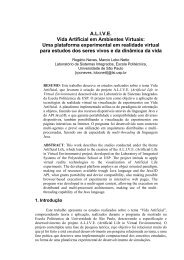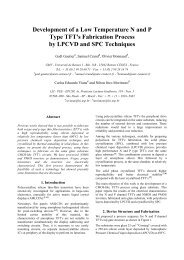JINX: An X3D Browser for VR Immersive Simulation ... - LSI - USP
JINX: An X3D Browser for VR Immersive Simulation ... - LSI - USP
JINX: An X3D Browser for VR Immersive Simulation ... - LSI - USP
You also want an ePaper? Increase the reach of your titles
YUMPU automatically turns print PDFs into web optimized ePapers that Google loves.
Some solutions <strong>for</strong> distributed virtual reality applications are<br />
available in scientific literature. The Syzygy [Schaeffer and<br />
Goudeseune 2003] is a library that allows the user to create<br />
powerful applications <strong>for</strong> clusters environments. It takes care of<br />
all the issues of synchronization, and has a very robust solution<br />
<strong>for</strong> network connection. But the Syzygy approach creates some<br />
complexity <strong>for</strong> the development of new applications. This is a<br />
problem <strong>for</strong> content developers that are not familiarized with<br />
programming.<br />
synchronized. The Datalock is basically necessary to guarantee<br />
the integrity of the in<strong>for</strong>mation in the nodes along the process and<br />
to avoid coherence problems.<br />
<strong>An</strong>other approach comes from the <strong>VR</strong>Juggler [Bierbaum et al.<br />
2001; Allard et al. 2002]. There are two distributions <strong>for</strong> cluster<br />
environments: NetJuggler [Allard et al. 2002] and Cluster Juggler<br />
[Bierbaum et al. 2003]. The <strong>VR</strong>Juggler is a powerful library that<br />
supports the development of virtual reality environments, but is<br />
not user-friendly. It has support <strong>for</strong> OpenSG [OpenSG], which<br />
creates some flexibility <strong>for</strong> content creation. Avango [Tramberend<br />
1999] and Lightning [Stoll et al. 2001] has also some support <strong>for</strong><br />
cluster, and some research has been done to make it more scalable<br />
[Hinkenjann et al. 2002]. Finally X-Rooms [Isakovic et al. 2002]<br />
is a distributed solution that provides support to online web<br />
content using a modified <strong>VR</strong>ML browser. It has powerful<br />
capabilities like speech recognition and stereo video streaming,<br />
but it is restricted to passive stereo.<br />
<strong>X3D</strong> is a new standard and just recently some browsers have been<br />
released. Xj3D [Xj3D] is the most important one, developed in<br />
Java and Java3D. It is used as a testing ground <strong>for</strong> <strong>X3D</strong>, but it<br />
does not yet support cluster distribution. The <strong>X3D</strong> <strong>for</strong>mat creates<br />
many advantages <strong>for</strong> our implementation. First of all this is a open<br />
standard, then it is easier to have a con<strong>for</strong>mance content, also the<br />
simplicity of this scene graph is very powerful <strong>for</strong> distributed<br />
systems.<br />
Our work is an innovative contribution since it is an integrated<br />
approach to a modular system that allows the user to run the<br />
application in virtually any plat<strong>for</strong>m. This modular system lets the<br />
user change any device specific plat<strong>for</strong>ms commands. For<br />
instance, it is possible to easily change between MPI and Sockets.<br />
Also, with the use of <strong>X3D</strong>, a great freedom of development is<br />
achieved, smoothing the transfer between the modeling tools and<br />
the virtual environment.<br />
3 Communication<br />
3.1 Synchronization<br />
The application presented in this paper allows the user to choose<br />
the communication system between the processes. At this moment<br />
MPI [Pacheco 1997] and TCP/IP sockets network streams are<br />
supported. All the in<strong>for</strong>mation, like the user position, direction<br />
and speed is packed and transmitted by networking every frame,<br />
since this in<strong>for</strong>mation is not too big. In a dedicated fast-Ethernet<br />
connection it is possible to get a maximum frame rate of about 60<br />
f/s and in a gigabit-Ethernet of about 240 f/s. We chose MPI<br />
because it is broadly supported and many network systems<br />
support some sort of MPI distribution.<br />
<strong>An</strong> important feature of the system is the Framelock and<br />
Datalock. In the solution proposed, this is done mainly by a<br />
barrier function. The Framelock blocks the graphical processes<br />
until all of them conclude their own image rendering. When all of<br />
them finish their rendering, a command that is issued at the same<br />
time in all graphical processes, swaps the frame buffer. Figure 1<br />
shows a system with two displays one synchronized and one not<br />
Figure 1 - Image with and without Framelock and Datalock<br />
A suggested intermediate locking is the Timelock, because <strong>X3D</strong> is<br />
animated and based on a specific time, there<strong>for</strong>e all computer<br />
nodes receive a time update at each frame, based on the master<br />
clock, and it is possible to predict the animation of the virtual<br />
objects, based on this time.<br />
Genlock is also an important resource <strong>for</strong> distributed<br />
environments. In complex cluster-based immersive visual<br />
environments, many video signals are necessary to show the<br />
images. The Genlock provides controls to synchronize multiple<br />
screens, Genlock per<strong>for</strong>ms four main functions: vertical,<br />
horizontal, frame, and color synchronization and it is necessary in<br />
active stereo systems, as the active glasses let you see a different<br />
image <strong>for</strong> each eye on each video refresh. <strong>JINX</strong> does not provide<br />
Genlock, but some graphics cards have a connector <strong>for</strong> the<br />
Genlock signal, which makes it very simple to synchronize the<br />
cards. If the graphics card does not support it, another solution is<br />
necessary. One of them is Softgenlock [Allard et al. 2002], which<br />
uses resources of a real time Linux kernel that allows sending<br />
synchronization signals across the parallel port.<br />
3.2 Connection<br />
The application developed can run in many processes, which are<br />
responsible <strong>for</strong> different activities. Figure 2 shows how the<br />
messages are transmitted across the system. This approach allows<br />
the use of heterogeneous clusters or even different architectures<br />
<strong>for</strong> different tasks. For instance the joystick could be connected to<br />
a node and the sound card to another one. This allows the use of<br />
the cluster with great efficiency.

















